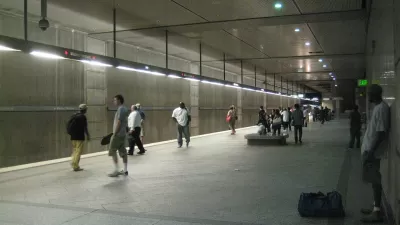Dave Sotero reflects on the "mammoth undertaking" necessary to build L.A.'s modern subway system. He begins with the completion of the first phase of the Metro Red Line 20 years ago, and ends with a look at its promising future.
David Sotero reports, "Today, Metro marks the 20th anniversary of the Metro Red Line’s first phase from Union Station to MacArthur Park, a nearly 4.5-mile construction milestone that began a brand new chapter in regional rail construction and placing L.A. among other major cities across the globe with high-speed, high-capacity subways."
He recounts its "quixotic" history, spearheaded by former Los Angeles Mayor Tom Bradley, which required "$1.431 billion for the initial segment" that was started in 1986 and opened in 1993. It faced construction challenges including a subway fire, buried fuel oil tanks, and the draining and refilling of an eight-acre lake. "Workers also found the oldest and most diverse collection of fossils ever reported from the L.A. Basin’s Miocene period — with some dating back 15.5 million years," he adds.
Subway development has introduced countless benefits, initially to Downtown Los Angeles, and later to Hollywood Boulevard, revitalizing neighborhoods, and offering Angelenos more "transit-friendly" lifestyle options. It created the “live, work and play” ethos that "continues to draw new residents, cultural venues and entertainment centers to invest in downtown," writes Sotero. And it has continued to expand phase by phase, segment by segment. "Following the subway’s opening to Westlake/MacArthur Park in 1993, consecutive construction phases brought the line to Wilshire/Western in 1996, Hollywood in 1999 and North Hollywood in 2000."
Despite its many benefits, continued expansion and increased ridership (reaching 48 million riders on the Red and Purple lines in 2012), Sotero points out that, "[o]ne of the peculiarities of the subway is that even today many residents in parts of the county have never used it or do not know it exists." "However," he adds, "that is likely to change as the subway moves from adolescence to maturity with the extension of the Metro Purple Line to the jobs-rich Westside."
The Expo Line is expected to open in Santa Monica in 2016 and the Metro Purple Line is expected to reach La Cienega Blvd by 2023, making its way to Westwood in 2036, "unless Metro finds a way to fund an acceleration of the project."
FULL STORY: First phase of Metro Red Line celebrates 20-year anniversary

Planetizen Federal Action Tracker
A weekly monitor of how Trump’s orders and actions are impacting planners and planning in America.

Chicago’s Ghost Rails
Just beneath the surface of the modern city lie the remnants of its expansive early 20th-century streetcar system.

San Antonio and Austin are Fusing Into one Massive Megaregion
The region spanning the two central Texas cities is growing fast, posing challenges for local infrastructure and water supplies.

Since Zion's Shuttles Went Electric “The Smog is Gone”
Visitors to Zion National Park can enjoy the canyon via the nation’s first fully electric park shuttle system.

Trump Distributing DOT Safety Funds at 1/10 Rate of Biden
Funds for Safe Streets and other transportation safety and equity programs are being held up by administrative reviews and conflicts with the Trump administration’s priorities.

German Cities Subsidize Taxis for Women Amid Wave of Violence
Free or low-cost taxi rides can help women navigate cities more safely, but critics say the programs don't address the root causes of violence against women.
Urban Design for Planners 1: Software Tools
This six-course series explores essential urban design concepts using open source software and equips planners with the tools they need to participate fully in the urban design process.
Planning for Universal Design
Learn the tools for implementing Universal Design in planning regulations.
planning NEXT
Appalachian Highlands Housing Partners
Mpact (founded as Rail~Volution)
City of Camden Redevelopment Agency
City of Astoria
City of Portland
City of Laramie




























